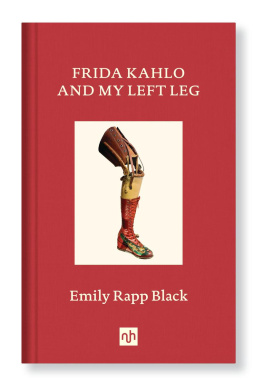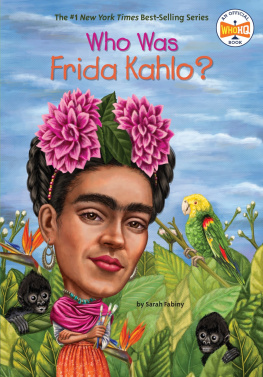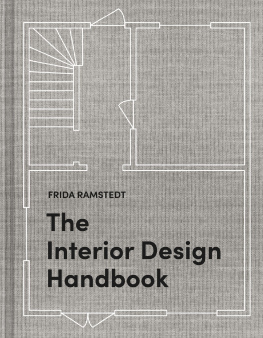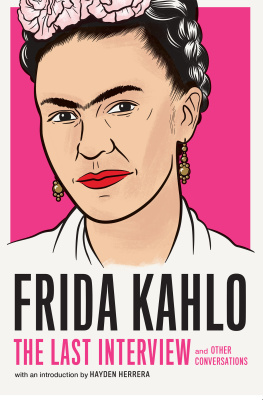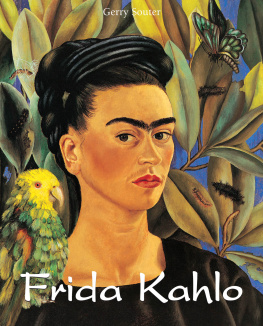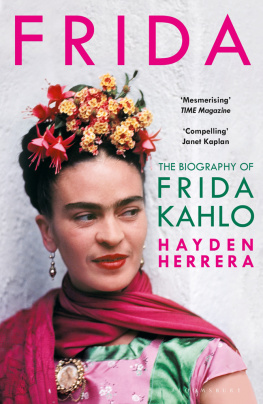Charlie Collins - Frida Style Icon
Here you can read online Charlie Collins - Frida Style Icon full text of the book (entire story) in english for free. Download pdf and epub, get meaning, cover and reviews about this ebook. year: 2022, publisher: Hardie Grant, genre: Science. Description of the work, (preface) as well as reviews are available. Best literature library LitArk.com created for fans of good reading and offers a wide selection of genres:
Romance novel
Science fiction
Adventure
Detective
Science
History
Home and family
Prose
Art
Politics
Computer
Non-fiction
Religion
Business
Children
Humor
Choose a favorite category and find really read worthwhile books. Enjoy immersion in the world of imagination, feel the emotions of the characters or learn something new for yourself, make an fascinating discovery.
- Book:Frida Style Icon
- Author:
- Publisher:Hardie Grant
- Genre:
- Year:2022
- Rating:3 / 5
- Favourites:Add to favourites
- Your mark:
- 60
- 1
- 2
- 3
- 4
- 5
Frida Style Icon: summary, description and annotation
We offer to read an annotation, description, summary or preface (depends on what the author of the book "Frida Style Icon" wrote himself). If you haven't found the necessary information about the book — write in the comments, we will try to find it.
Frida Style Icon — read online for free the complete book (whole text) full work
Below is the text of the book, divided by pages. System saving the place of the last page read, allows you to conveniently read the book "Frida Style Icon" online for free, without having to search again every time where you left off. Put a bookmark, and you can go to the page where you finished reading at any time.
Font size:
Interval:
Bookmark:


The magnetism of the creative universe brought into being by style icon Frida Kahlo is so great that many of us have, at one time or another, been pulled into it. Her legacy of paintings, photographs, letters and diary entries, as well as her astounding wardrobe, have transfixed and fascinated a global audience.
Frida has inspired entire fashion collections from the likes of Jean Paul Gaultier and Christian Lacroix, and ignited her very own movement, Fridamania, which has been responsible for garish flower crowns and pencilled monobrows sweeping across the globe. You would be hard-pressed to find any other woman in history whose face has graced such a wide variety of everyday objects, from coffee mugs to plant pots.
Although Fridas life was cut short, it was extraordinary. Born to a German father and a Spanish and indigenous Indian mother, Fridas life was full of interesting dualities from whose complexities she wove the fabric of her creative existence. She delighted in subverting expectations, running from her devout Catholic upbringing into the arms of the Communist Party and finding her raison dtre and her husband within its ranks.
Fridas obsession with Diego Rivera, the Mexican muralist and an outspoken member of the Communist Party, was one from which she would never free herself and he quickly became the life force driving her work. His artistic talent and overwhelming charisma afforded him a valuable notoriety in post-revolutionary Mexico and offered Frida Kahlo a ticket out of the sleepy suburbs. Together, they became a force to be reckoned with, dazzling everyone who met them with their art, their style and their eccentric bohemian lives.
However, Fridas life was not all painting, partying and politics. It was dominated by extreme physical pain, caused by the numerous misfortunes that life handed her. A bout of polio as a six-year-old child caused her right leg to wither and she developed a limp; later, a bone-shattering bus accident would leave her body broken. She would learn through heartbreaking experience that she was unable to carry a baby to full term, and the physical aftershocks of her bus accident would condemn her to a lifetime of excruciating plaster corsets and painful operations.
Yet with pain came potential, and Frida began to transform her suffering into terrifying beauty, brushstroke by brushstroke. Her misfortunes fed the state of being from which her work drew its emotional force, and the physical challenges that her injuries presented informed the imagery which would go on to make her an icon.
Fridas fierce attitude held the key to her iconic look. She dressed in as bold a manner as she lived, cultivating an entirely original style that was punctuated by many wonderful contradictions. She was complex and original, instinctive and intuitive, wild and passionate she was one-of-a-kind. She refused to be contained by a single definition of what it meant to be a woman and an artist in her time.
Frida chose to wear traditional garments that represented post-revolutionary Mexico, adopting the spectacular Tehuana dress that her mother had worn before her and hanging the revolutionary rebozo about her shoulders. She would offset these inherently Mexican pieces with European blouses and statement costume jewellery that she picked up on her far-flung travels accompanying Diego on his art expeditions.
Beautiful clothes were part of Fridas daily celebration of life and she took great pride in assembling her outfits, from braiding her hair with brightly coloured ribbons to customising her shoes with embroidered panels and jingling bells. Where other female artists of her time were painting in masculine overalls, Frida created her masterpieces in her most formal attire, allowing paint to splatter over the precious silks of her finest garments.
Frida exerted control over her physical misfortunes through style, wrapping her thinner leg in layers of socks and hand-painting dreamscapes over the plaster corsets that confined her. She was a master of visual manipulation, concealing herself in an armour of sumptuous silks and distracting onlookers with the dazzling details of her outfits.
In her short lifetime Frida Kahlo produced dozens of hypnotic self-portraits that attempted to explore her identity through her own reflection. Like Narcissus, she was entranced by her own image and spent hours studying her face in the many mirrors that hung about La Casa Azul (The Blue House), her childhood home, which would later go on to become the Frida Kahlo Museum. Her distinctive clothing often appears in her paintings, blurring the lines between biography, art and fashion.
Fridas hypnotic image drew scores of photographers towards Mexico, racing across oceans in an attempt to capture her unusual beauty. And she continues to exert power to this day, holding viewers captive and attracting an ever-growing army of global Frida Kahlo fans.
Frida Kahlo: Style Icon is a pure celebration of Fridas very special kind of fashion magic. From the dramatic life events that helped to shape her attitude towards clothes, to the half-forgotten garments and cosmetics rediscovered in 2004, this book takes a fresh look at Fridas showstopping style.
I hope you enjoy reading this book as much as I enjoyed writing, but most of all, I hope it allows you to be a little braver, a little bolder, and a little truer to your wonderful uniqueness in honour of the endlessly inspiring Frida Kahlo.

Frida Kahlos discerning eye was cultivated from a young age. As a child she picked up fragments of inspiration that would go on to influence her voracious appetite for beauty and style in later life.
Frida Kahlo was born on 6 July 1907 in an affluent suburb of Mexico City called Coyoacn.
Although Frida arrived in the world as the third of four daughters born to Guillermo Kahlo and Matilde Caldern y Gonzlez, she was never going to play the role of the passive middle child, nor play up to the harmonious meaning of her name in German: peace.
Instead, Frida was like a hurricane whip-smart, with a wicked laugh and sharp tongue with pranks exploding from her like dynamite. Frida loved carrying her world around with her, cramming her backpack full of keepsakes such as rocks, stuffed animals, dried butterflies and feathers, much to the intrigue of her school friends.
From her earliest years Frida followed her passions instinctively. Feeling no obligation to please people, she allowed her unruly spirit to flourish and carved out a unique identity that emblazoned her in the minds of all who knew her.
No one could forget meeting Frida Kahlo a pattern that was set to continue for the rest of her life.

In 1913, at just six years old, Frida was struck down with polio, causing her right leg to grow thin and weak, leaving her confined to her bedroom for nine long months.
Fridas dark wooden bed with its carved canopy was to become her tiny kingdom as her waking thoughts began to merge with the surreal substance of her dreams like paint in water.
Fridas imagination grew wings and with them she travelled beyond the confinements of her bedroom and journeyed deep into the realm of her subconscious. It was on these travels that she met her beloved imaginary friend, a little girl about the same age as her, who appeared to be full of joy and vivacity and offered Frida the companionship she so desperately needed. She recognised that she could be both these little girls at once: sad, lonely and introverted and, on the flip side, bold, gregarious and full of gaiety. The little girl she met in her imagination was the beginning of her lifelong fascination with exploring the subject of her dual identity the beginning of The Two Fridas.
Next pageFont size:
Interval:
Bookmark:
Similar books «Frida Style Icon»
Look at similar books to Frida Style Icon. We have selected literature similar in name and meaning in the hope of providing readers with more options to find new, interesting, not yet read works.
Discussion, reviews of the book Frida Style Icon and just readers' own opinions. Leave your comments, write what you think about the work, its meaning or the main characters. Specify what exactly you liked and what you didn't like, and why you think so.


